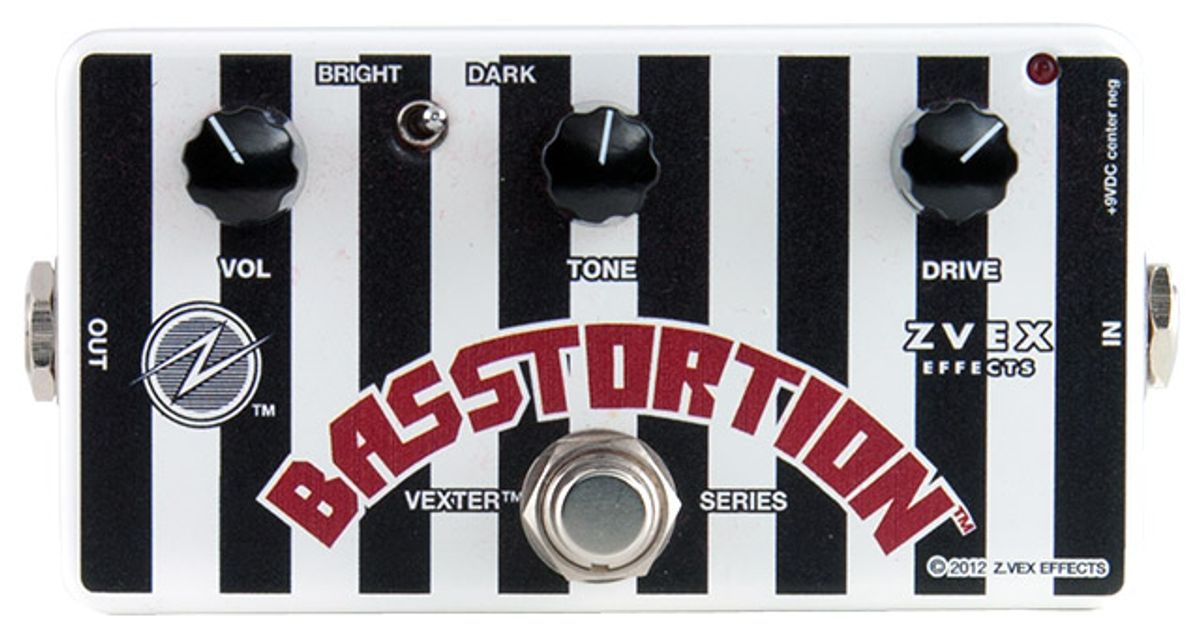
The mad scientists at Z.Vex dial up some amp-inspired overdrive tailored specifically for bassists with the Basstortion.
Pedal builders truly are the mad scientists of the music industry, and these sonic alchemists tirelessly toil in their labs with the shared goal of concocting brave, new tonal spices for players to add to their sound. One of these sound scientists is Zachary Vex. And this mighty Minnesotan has been building pedals since the mid ’90s, attracting pedal-procuring artists such as Matt Bellamy, J Mascis, and Nels Cline. When it came to Vex’s attention that some of his bassist friends were integrating his guitar effects into their signal chain, he and his team felt it was time to build more bass-friendly boxes.
One such pedal is the Basstortion—the company’s new stompbox for low-enders that’s intended to serve up tube amp-inspired overdriven sounds and dynamic responsiveness.
Spawn of ’Tron
The Basstortion is based on Z.Vex’s Distortron pedal for guitar, and the knob layout is similar to the popular box, consisting of volume, tone, and drive controls. But instead of including the Distortron’s sub switch (for added lows) and gain switch, Z.Vex placed a bright/dark switch between the volume and tone knobs. This switch works along with the tone control to give the sound an edge or a mellow vibe, depending on the desired outcome.
The Basstortion’s main objective is to deliver a tube-like overdrive that’s similar to a cranked SVT, as opposed to a fuzz effect from Z.Vex’s Mastotron and Woolly Mammoth pedals. And like the natural overdrive from a tube amp, the pedal is designed to respond to the touch, so players can hear variances in the breakup as their picking dynamics change.
Striped Simplicity
Upon first inspection, the Basstortion appeared to be one well-built device. The solid-metal chassis and tough components assured me that this pedal could handle the rigors of the road and probably survive a few mishandlings.
Removing the bottom plate revealed a clean circuit board and well-organized wiring. Due to the compact space in the relatively small pedal, the battery was in pretty close proximity to the input and output jacks. Not a huge issue if the jacks are properly insulated to prevent any potential contact with the battery, but in this case, a piece of electrical tape was used to cover the end of the output jack. Electrical tape isn’t the most durable of insulators, and if the pedal was jostled enough, it could loosen the tape and potentially result in ground-outs.
With that small gripe aside, it was time to see how well the Basstortion could introduce some SVT-ness into a clean signal. To get started, I connected the pedal to a Phil Jones D-600 head and a pair of Glockenklang 112 cabinets. It didn’t take long to get comfortable with the user-friendly Basstortion. Whether dialing in the tone control for a biting, snarling sound with a Fender Modern Player 4-string, or by maxing out the drive control to assist a Nash P-style bass in sounding more like a giant light saber, the pedal proved very intuitive.
The bright/dark switch was quite useful. And while my ears preferred the tonal variety available in the bright setting, having the option to mellow out the sound with the dark mode could certainly be a benefit when playing naturally brighter basses.
Another impressive aspect of the Basstortion was the level of note definition, regardless of the amount of drive on the signal. The effect responded nicely to variations in touch, applying a satisfying bump in the overdrive when I dug into the strings. Overall, the Basstortion did what it’s intended to do by adding a bit of tube emulation to a modern rig.
Ratings
Pros:
An easy-to-use pedal capable of producing some tasty, overdriven sounds.
Cons:
Unable to fully attain SVT nirvana. On the pricier side.
Tones:
Ease of Use:
Build/Design:
Value:
Street:
$199
Z.Vex
zvex.com
David and Z.Vex Versus Goliath
Pleased with what the Basstortion could do in a medium-volume
environment, I wanted to A/B the Basstortion next to the real thing—a
’70s “Blue-Line” SVT and its matching 8x10 cabinet. The Basstortion was
paired with a Markbass Little Mark Tube 800 digital amplifier, which is
rated at 800 watts at 4 Ω. This modern duo was plugged into the SVT-810
cab, and after a bit of tweaking, the combination conveyed plenty of
volume with a significant amount of breakup in the tone.
While it came as no surprise, however, that the Basstortion couldn’t quite muster the same beefy lows and huge gain that the SVT amp produced, those who like a controlled, edgier overdrive might like what the Basstortion has to offer. And let’s not forget that Z.Vex’s pedal is considerably easier to move around than the Goliath rig it proudly took on this day.
The Verdict
Z.Vex describes the Basstortion pedal perfectly in three words—simple, flexible, musical. Though it may not appeal to bassists looking for more authentic and burly sounds, oldies and newbies to the world of bass effects will find the Basstortion very user friendly for adding just the right amount of hair on their tone. And with its road-ready construction and small stature, it will fit in nicely on a number of players’ pedalboards.
The only real concern I had with the Basstortion was the price point. The pedal streets at $199, and there are other options out there that might offer a bit more for a bit less money. But overall, it’s definitely a solid choice for those running a solid-state rig that want to inject a controlled amount of overdrive at the stomp of a switch.


